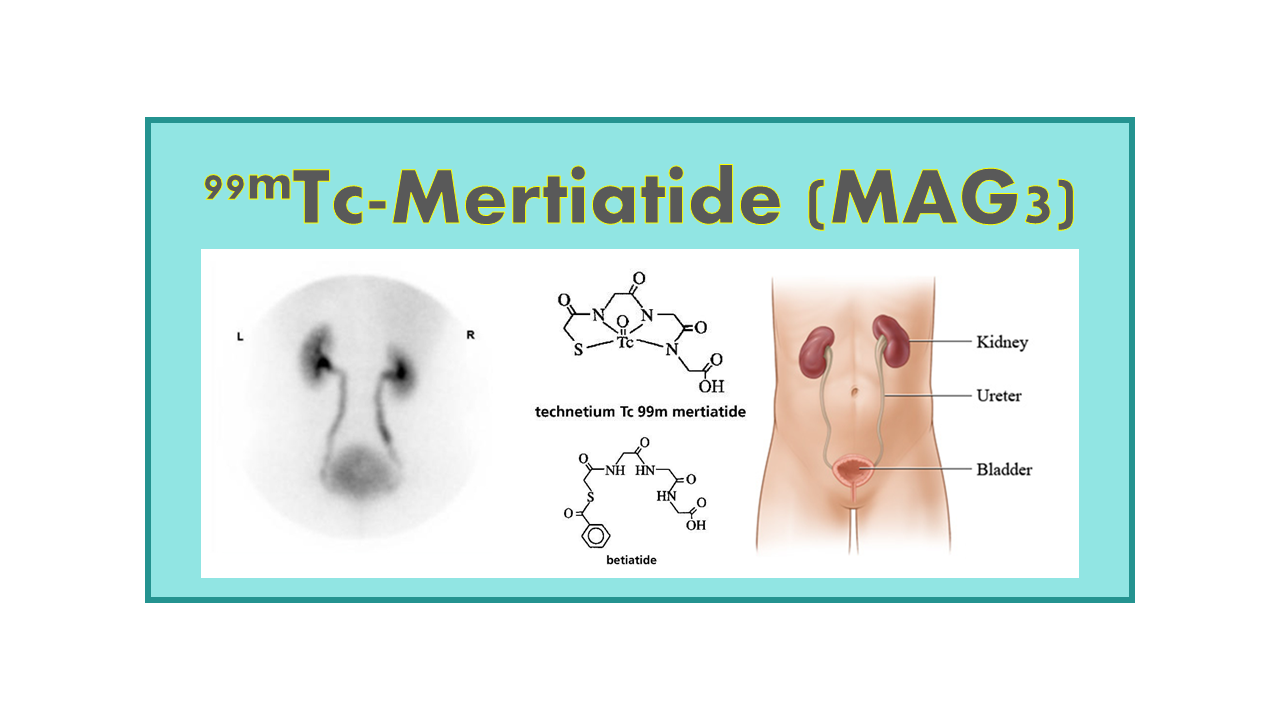
99mTc-Mertiatide (MAG3) or 99mTc-Betiatide
April 12, 2024
99mTc-Mertiatide (MAG3):
99mTc-Mertiatide, also known as MAG3 (mercaptoacetyltriglycine), is a radiopharmaceutical used in nuclear medicine for renal imaging. MAG3 is a tubular agent that is primarily excreted through the kidneys. It is taken up by the renal tubular cells and excreted into the urine, allowing for the visualization of the renal parenchyma and assessment of renal function. MAG3 renal scintigraphy is commonly used for evaluating renal perfusion, function, and drainage. It is particularly useful in assessing renal obstruction, renovascular hypertension, and renal transplant function. MAG3 is preferred over other renal imaging agents due to its rapid renal clearance, low protein binding, and minimal extrarenal accumulation.
99mTc-Betiatide:
99mTc-Betiatide is another radiopharmaceutical used for renal imaging, similar to MAG3. Betiatide is also a tubular agent that is excreted through the kidneys, allowing for the visualization of renal function and anatomy. Betiatide renal scintigraphy is utilized for the same indications as MAG3, including the assessment of renal function, perfusion, and drainage in various renal pathologies. While Betiatide shares similar properties with MAG3 in terms of renal clearance and imaging capabilities, its specific advantages may vary based on individual patient characteristics and clinical scenarios.
Both 99mTc-Mertiatide (MAG3) and 99mTc-Betiatide are valuable tools in renal imaging, offering clinicians insights into renal structure and function for the management of various kidney-related conditions.
Diagnostic of Renal Function: Renal function can be assessed through various imaging modalities and functional tests. One common method is renal scintigraphy using radiopharmaceuticals like 99mTc-MAG3 or 99mTc-Betiatide, which are excreted through the kidneys and allow for the visualization of renal function, perfusion, and drainage. These tests provide valuable information about the overall function of the kidneys and can help in diagnosing conditions such as renal obstruction, renovascular hypertension, and renal transplant function.
Split Function: Split renal function evaluation is crucial in assessing the individual function of each kidney. This can be done using nuclear medicine techniques where each kidney’s function is measured separately. Discrepancies in split renal function can indicate underlying renal pathology or help in preoperative planning for surgeries such as nephrectomies.
Renal Angiograms: Renal angiograms are imaging studies that visualize the blood vessels supplying the kidneys. These studies are essential in diagnosing conditions like renal artery stenosis, renal artery aneurysms, or vascular malformations affecting renal blood flow. Renal angiograms can help guide interventions such as angioplasty or embolization to address vascular issues impacting renal function.
Renogram Curves for Whole Kidney and Renal Cortex: Renogram curves obtained from renal scintigraphy provide valuable information about the function of the whole kidney and renal cortex. The renogram curve reflects the uptake and clearance of the radiopharmaceutical by the kidneys over time, showing distinct phases such as vascular, parenchymal, and excretory phases. Analysis of renogram curves can help in assessing renal blood flow, tubular function, and overall kidney function, providing clinicians with insights into renal health and guiding treatment decisions for renal disorders.
Description
99mTc-Mertiatide (99mTc-Mercapto-acetyltriglycine) is in fact also available under a slightly different formulation involving a precursor, betiatide (99mTc-S-benzoyl-Mercapto- acetyltriglycine, 99mTc-MAG3). Both tracers are used for the same indications in kidney imaging.
Clinical applications
99mTc-Mertiatide is a diagnostic aid in providing renal function, split function, renal angiograms and renogram curves for whole kidney and renal cortex. It can also be used in the diagnosis of congenital and acquired abnormalities, renal failure, urinary tract obstruction and calculi. The typical dose of MAG3 in adults is 5 mCi, but can reach 10 mCi. The critical organ is the bladder wall.
Availability
99mTc-Mertiatide/Betiatide is available from Cyclopharma (NephtoMAG®), DiaMed (Technemag, Russian MA 1997), Fuji Film (Techne® MAG3), Mallinckrodt (Curium) (Technescan MAG3®, US MA 1990).
A final labeled dose of 99mTc-Mertiatide did cost in the past about EUR 200-220 (US$ 220-250) for a dose of around 10 mCi, but in September 2019 Curium decided to change its price policy and increased the average price per vial of 99mTc-Mertiatide to approximately US$ 625 for most US customers. In 2020 in the USA, a dose of reconstituted 99mTc-Mertiatide is now charged around US$ 800-900
Competition
Several tracers are used for the same indication such as 123I-Orthoiodohippurate and 99mTc-DTPA. Compared to 123I-Orthoiodohippurate, 99mTc-Mertiatide has a lower renal clearance but a similar excretion rate. Mertiatide also has higher protein binding resulting in higher image quality, which is also better when compared to 99mTc-DTPA.
Comments
99mTc-MAG3 belongs to the common SPECT radionuclides used routinely by nuclear physicians.